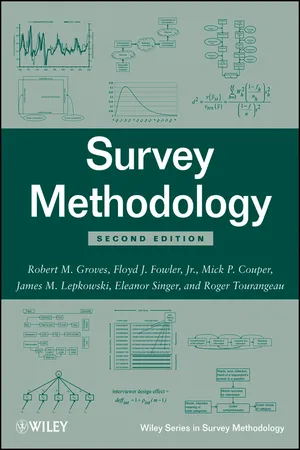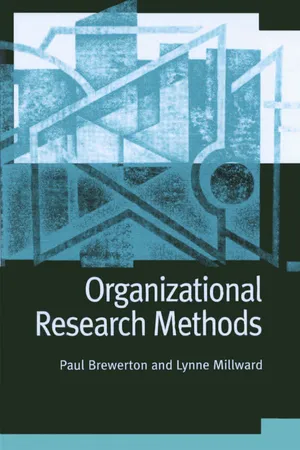Mathematics
Methods of Data Collection
Methods of data collection in mathematics refer to the various techniques used to gather numerical or categorical information for analysis. Common methods include surveys, experiments, observations, and interviews. Each method has its own strengths and limitations, and the choice of method depends on the nature of the data and the research objectives.
Written by Perlego with AI-assistance
Related key terms
11 Key excerpts on "Methods of Data Collection"
- eBook - ePub
- Paul Oliver(Author)
- 2010(Publication Date)
- SAGE Publications Ltd(Publisher)
7
Data Collection Methods
Chapter objectivesThis chapter will help you to:- Understand Methods of Data Collection in the social sciences.
- Examine the terminology used to discuss data collection methods.
- Familiarize yourself with methods of data analysis.
Terms usedThe following terms are discussed in this chapter: accounts; bias; biography; closed question; coding; content analysis; covert observation; data collection instrument; documents; fieldwork; gatekeeper; inference; insider; internet-based survey; interviews; key informant; multiple choice question; multiple perspectives; narrative account; nominal data; null hypothesis; open question; outsider; participant observation; participants; postal questionnaire; questionnaire; rating scale; reactivity; reflexivity; respondents; simulation; subjects; telephone survey; theoretical sampling; transcription.Methods of Data Collection
On a philosophical level, the way in which researchers will collect data is connected to their approach to ontological and epistemological questions; in other words, to their overall view of the nature of reality, and to their idea of what should count as valid knowledge. Sometimes also, the subject matter of the research project will be a determining factor in the choice of a method of data collection. If we are interested in examining an issue which involves deeper human feelings, and where the emotions involved are very complex, then we may decide that we require a method which is capable of collecting rich, detailed data. In such cases, we may decide to employ the methods usually associated with qualitative enquiry. One popular method used in such a context is participant observation.The essence of this approach is that we will observe a particular social context while at the same time engaging to a certain extent with that situation. While collecting data, we will try to become a part of the social context. This immediately reveals practical and philosophical issues connected with the approach. Social situations are living, evolving entities in which individuals are continually interacting and changing the situation. Imagine an office, a restaurant, a sports club, or a hospital. These are all social contexts with their own complex range of human interactions. On every occasion when a stranger enters that situation, the social interactions will inevitably change. People may talk to the newcomer, trying to place them in the social context. They might try to make sense of their presence, and locate them in the social network of the situation. Researchers will inevitably have this type of impact, and ironically in a way, will change the very situation which they are trying to understand. It is very difficult then for an observer to be detached from a social situation. Observers have to accept that they will be, to varying degrees, part of the situation they are researching. - eBook - ePub
- Brynard DJ, Hanekom SX, Brynard PA(Authors)
- 2014(Publication Date)
- Van Schaik Publishers(Publisher)
8 Methods for collecting dataLearning objectives After studying this chapter, the researcher should be in a position to apply the most common techniques used in the data collection process.8.1 IntroductionThe most time-consuming part of research is the collection of data. This activity must be done, however, because without data, it would not be possible to broaden one’s understanding, explain the “unknown”, or add new knowledge to existing knowledge.Research methodology is the “how” of collecting data, and the processing thereof within the framework of the research process. Two basic methodologies for collecting data can be distinguished, namely quantitative and qualitative methods. Both methods make use of specific techniques to collect data, inter alia , literature reviews, interviews, questionnaires and direct observation.Instruments such as attitude scales and rating scales have been developed to measure the reliability of the data collection methods. In turn, the validity and reliability of measuring instruments have to be tested. Sampling, which can be used in data collection and which, at the same time, can also contribute to greater accuracy of the results of the data, is also discussed.
Effective research requires research resources or instruments, of which the following are generally used:8.2 Research instruments• An academic information centre or library with appropriate sources for the purposes of a literature review• Measuring instruments to quantify information in order to obtain data for statistical analysis (e.g. performance tests, aptitude tests)• Statistics that can be used to explain the presence of phenomena quantitatively
When researchers collect their own data, it is called primary data. Should they use data collected by other researchers concerning other research problems, this data is referred to as secondary data.8.3 Primary and secondary dataData is based on facts and can be classified into two types: quantitative data (e.g. the weight of an object expressed in kilograms) and qualitative data (e.g. the colour of an object can be described by its quality of being red, white or blue). Qualitative data and qualitative research go hand in hand (Bless & Higson-Smith, 1995: 99–100). - eBook - ePub
- Robert M. Groves, Floyd J. Fowler, Mick P. Couper, James M. Lepkowski, Eleanor Singer, Roger Tourangeau(Authors)
- 2011(Publication Date)
- Wiley(Publisher)
CHAPTER FIVE Methods of Data CollectionNo matter how good its sample design, a survey will yield biased results if the rest of the survey design is not appropriate to its purpose. This includes writing and testing a measurement instrument, typically a questionnaire (see Chapters 7 and 8). In addition, if interviewers are used, they must be recruited, trained, and supervised (see Chapter 9). This chapter focuses on another key set of decisions that affects the survey, that is, the method of data collection used.The term “data collection” is a little misleading, since it implies that the data already exist and merely need to be gathered up (see Presser, 1990). Survey data are usually produced or created at the time of the interview or completion of the questionnaire. In other words, they are a product of the data collection process, a notion that underscores the importance of this step. Despite this, we will use the usual terminology of “data collection” here. As Figure 5.1 shows, all design aspects flow through the data collection process to produce survey estimates. The two inferential steps described in Chapter 2 come together in the data collection process. Although often viewed as an operational step following design, data collection is an essential element in the production of useful data for analysis and is subject to empirical research informed by theory. This chapter focuses on decisions related to the choice of a data collection method and the implications of such decisions on costs and errors in surveys.Surveys have traditionally relied on three basic data collection methods: mailing paper questionnaires to respondents, who fill them out and mail them back; having interviewers call respondents on the telephone and asking them the questions in a telephone interview; and sending interviewers to the respondents’ home or office to administer the questions in face-to-face (FTF) interviews. The computer revolution has altered each of these traditional methods and added new ones to the mix. Not only has there been a proliferation of methods, but researchers are increasingly combining modes to minimize costs and/or errors. This has greatly expanded the design choices that need to be made during this phase, and the need for research evidence to inform such choices. This chapter focuses on the decisions related to the choice of a data collection method and the implications of such decisions on costs and errors in surveys. There are two basic issues that affect the choice of a data collection method: - eBook - ePub
Action Research for Improving Educational Practice
A Step-by-Step Guide
- Valsa Koshy(Author)
- 2009(Publication Date)
- SAGE Publications Ltd(Publisher)
In the following section, we will look at methods for data collection which are commonly used within action research. Data collection methods are also referred to as methods of instrumentation. Before exploring the different methods, let me provide you with two important points which all researchers could usefully bear in mind when planning their data collection.- There are many ways of gathering data; you have to choose the most suitable method for the task in hand.
- The quality of the data you collect is more important than the number of ways you collect that data.
- using questionnaires;
- conducting interviews;
- gathering documentary evidence;
- keeping field diaries and making notes;
- using systematic observation.
For each method of data-gathering, I have tried to provide some general guidance as well as indicate various advantages and any possible disadvantages for that particular method. Some examples are given in those sections that I felt needed exemplification.Gathering data questionnaires and surveys
Using questionnaires at the start of a project can often be very useful because it helps you to collect a range of information with relative ease which can then be followed up as necessary. For example, if you are carrying out a study on how an intervention programme may help to change student attitudes towards learning a particular subject, use of a questionnaire will provide you with a simple means to collect information on student attitudes, before any intervention takes place. The completed questionnaires can help in two ways. Firstly, they provide baseline data on student attitudes before the intervention begins. Secondly, an analysis of the questionnaires may help to shape the nature of the questions you may want to ask during any interviews or observations you might conduct. Within a questionnaire, you can use both short questions and open-ended questions which need fuller responses. When working with children, I often find they enjoy the experience of completing the questionnaires so they can be encouraged to provide full information in response to questions. It is possible to set up questionnaires on-line and experience shows that students do prefer to complete these as opposed to pencil and paper versions. - eBook - ePub
Organizational Research Methods
A Guide for Students and Researchers
- Paul M Brewerton, Lynne J Millward(Authors)
- 2001(Publication Date)
- SAGE Publications Ltd(Publisher)
In many cases, the selection of your study’s design will have suggested the use of one or more particular data collection methods. However, it is worth taking time to consider all available Methods of Data Collection, their specific advantages and disadvantages and their suitability to your research question before setting out to collect your data. This chapter aims to describe some of the more popular Methods of Data Collection, their advantages and drawbacks, and the ways in which they can be practically applied.Figure 6.1 , below, illustrates the continuation of the research process, from securing organizational access and selecting a study design through to final reporting and presentation of study findings. Throughout the process of data generation and collection, it may be necessary to revisit earlier stages in order to collect additional supplementary information using alternative techniques, or to simply collect more data where findings are inconclusive or stimulate further questions.The next few chapters explore each of these stages in depth, as outlined below:- Chapter 6 : Methods of Data Collection – introduction to a number of data collection/generation techniques, including critiques and real-world examples;
- Chapter 7 : Sampling considerations – the importance of sampling in research;
- Chapter 9 : Data analysis – qualitative and quantitative analysis of data and how to interpret what findings mean;
- Chapter 10 : Reporting research findings – for academic and organizational audiences. Chapter 8 considers an issue specific to many research ventures in organizational settings: the measurement and analysis of ‘performance’, what this means and how it might be achieved.
Figure 6.1 The research process continues6.2 Criteria for selecting a method
In order to select an appropriate method to explore your research question, it is worth considering the following points. The method must be:- Appropriate to your research objective;
- Able to elicit a form of data appropriate to testing your hypothesis/hypotheses or addressing your research question(s);
- Feasible given time, resource and organizational constraints and requirements;
- eBook - ePub
- Kerry E Howell(Author)
- 2012(Publication Date)
- SAGE Publications Ltd(Publisher)
THIRTEEN
Methods of Data Collection
Introduction
No matter what philosophical position or paradigm of inquiry is used in a research project, it is always possible to use a combination of research methods when collecting data. The rationale for the balance between these methods will depend on the objectives of the research and the extent to which qualitative or quantitative techniques are to be utilised. This said, when undertaking positivist and post-positivist approaches the likelihood will be that quantitative methodologies and surveys and structured interviews will predominate. For phenomenological studies, incorporating critical theory, constructivist and participatory paradigms of inquiry, it is likely that qualitative data will be collected through interviews, focus groups and observations. Quantitative data collected through surveys allow quick, clean and relatively inexpensive modes of data collection. However, such requires sampling techniques that ensures the data is representative of the population the study proposes to analyse. If the sample does not correspond with the population then generalisation and the ability to predict will be negated; that is, statistical techniques will be undermined.Definition BoxSampling
Sampling is usually confined to positivism, post-positivism and the quantitative methods involved with these approaches. Samples involve certain groupings incorporated within a population, for example, a set of companies within a sector or number of individuals within a company or department. The sampling frame involves a record or listing of the total population from which the samples are drawn (a list of the companies in a sector or record of individuals within a company or department). On occasion it may be possible to use the entire population. However, in a large positivist or post-positivist study a representative sample of the population will be required that should be objective, random and as large as possible. That said, sampling techniques are used by grounded theorists and especially by those who follow the Strauss and Corbin variant (see Chapter 9 - eBook - ePub
- Graham Birley, Neil Moreland(Authors)
- 2014(Publication Date)
- Routledge(Publisher)
4Data CollectionThe data collecting part of a project is where many researchers feel the ‘real’ research occurs. Data collecting can be addictive, and can seriously endanger the health of the researcher and the completion of the research! Nonetheless the ‘fieldwork’ is where new information is acquired and its significance begins to be assessed.Data collection is not just a process of collection, it is also a process of creation – of using information in unique ways related to the purposes of the study. There is a wide variety of data collecting methods available to researchers in the social sciences; deciding which to use will depend on:■ the particular methodology that has been selected (objectivist or constructivist, quantitative or qualitative (or mixtures of both)■ what is feasible in a given research situation■ what is likely to yield the most appropriate information.All these items are decided upon in the context of the particular research problem. Some of the more important data collecting methods are listed below.■ Questionnaires■ Interviews■ Documents■ Observations■ Accounts and protocols■ Dialogue records■ Tests■ Diaries and field notes■ Sociometry■ Focus groups■ Action research■ Repertory grid methods■ Attitude Scales■ Evaluation research■ Written and other works of various kinds (eg books, essays, computer assignments).Many of these data collecting methods have alternative forms. Observations, for instance, may be participant or non-participant, while interviews may be structured, semi-structured or unstructured. Despite this variety there are some basic principles which apply to all data collecting methods.BASIC PRINCIPLES OF DATA COLLECTIONFirst, any method must produce data that is relevant to the research question(s), and able to provide answers or illumination on the topic. Second, the technique must be convenient and relatively easy to use in the circumstances, for the researcher has to be sure that the expenditure of time (and resources) is warranted by the project. Perhaps most important, however, are issues of validity and reliability of the research techniques used. - eBook - ePub
- David Crowther, Geoff Lancaster(Authors)
- 2012(Publication Date)
- Routledge(Publisher)
6 An Overview of Data Collection: Approaches, Methods and Techniques
After completing this chapter you will be able to:Learning Outcomes - understand the importance of, and steps in, a systematic and planned approach to data collection;
- understand the main types of data categories and be familiar with the alternative Methods of Data Collection;
- discuss the key issues in data collection;
- understand the criteria in choosing between data collection approaches.
Introduction Virtually every management research project will involve the collection of data in some form or other, as this will be necessary in order to undertake the project. Once the research or consultancy topic has been selected and the terms of reference agreed through the brief, then, the research plan will encompass the approaches to, methods of, and specific techniques to be utilized for data collection.The usual problem for the management researcher or consultant when it comes to data is not the lack of it, or at least the potential for it, but rather the potential abundance of it. Quite simply, unless the researcher is careful he/ she is likely to end up overloaded with data that sometimes as a result they have little idea what to do with. Above all, the researcher should resist the temptation to collect everything in sight. Data collection must be well planned and managed if the researcher is not to become hopelessly overwhelmed and the data be a barrier rather than an aid to the research project. Planning and managing data collection systematically requires an understanding of the different types of data allied to the different approaches to, methods of, and specific techniques of data collection. Provided the researcher knows what sort of data is required, it is then that we can proceed to select between the different approaches, methods, and techniques of data protection, and plan the data collection process accordingly. - eBook - ePub
Writing Successful Undergraduate Dissertations in Social Sciences
A Student's Handbook
- Francis Jegede, Charlotte Hargreaves, Karen Smith, Philip Hodgson, Malcolm Todd, Julia Waldman(Authors)
- 2020(Publication Date)
- Routledge(Publisher)
Table 7.1 , to which we have added suggestions for when they might be appropriate to deploy.Table 7.1 Strengths and weaknesses of different Methods of Data CollectionData collection method Strengths Weaknesses Observations - Ability to record events as they occur
- Evidential – if electronic recording of events or transaction is used
- Data accuracy depends on observational skills
- Data/manual notes tend to be subjective and based on what is important to the observer or notes taker
- Events may not be replicated to obtain similar results
Experiments (laboratory/field-based) - Follows logical scientific principles – inferences and reasoning
- Replicable – can be repeated to obtain same results
- Verifiable – peer review scrutiny
- Generalisable
- Generate strong internally valid data
- Weak level of generalisation
- Results may not always apply to real-life situation – as real life is more complex
Case studies - Good for testing hypotheses or interpreting theories
- Can generate social, cultural, and political data to explain a particular problem
- Data collected tends to be qualitative in nature and contextualised
- Reliability depends on the observational skills and integrative ability of the researcher
- Difficult to establish cause-effect relationships
- Not easily generalisable – as a single case study may not be readily applicable to all other cases
- eBook - ePub
Becoming a Teacher through Action Research
Process, Context, and Self-Study
- Donna Kalmbach Phillips, Kevin Carr(Authors)
- 2014(Publication Date)
- Routledge(Publisher)
HAPTER 3ACTION RESEARCH METHODOLOGYScience states meanings; art expresses them…. The poetic as distanced from the prosaic, esthetic art as distinct from scientific, expression as distinct from statement, does something different from leading to an experience. It constitutes one.—John Dewey, Later WorksResearch (and good teaching) is both the science and art of gathering trustworthy data to inform practice. Chapter 3 describes principles of data collection methodology. The data collection process may appear fairly straightforward; however, the side roads of Chapter 3 touch on issues of cultural context and how this influences decisions about methodology. As you read the chapter, ask: what methodologies best support my inquiry and critical question? How can I collect purposeful data? How can I plan for trustworthiness?Introduction to Data Collection MethodsOne cannot have an action research project without data. Data becomes the evidence of hunches, a confirmation of theory, and the source of paradigm shifts. Data is the evidence you will use to respond to your critical question(s) and develop further questions around your research interest. Data underlies the trustworthiness of your project, measuring its depth and defining its usefulness, determining the richness of your experience. Deliberate data collection is the extended eyes, ears, and soul of the teacher; it is the way we come to know our students, change our practice, and grow our teaching identity.Data collection and interpretation share much with good classroom assessment. We know that assessment drives instruction. As teachers, we assess our student knowledge, skills, and/or conceptual development in any given area using multiple means so that we can make wise instructional choices. This is the same process in action research: we collect data (forms of assessment) so that we can make wise instructional choices. We circle back to the concept that we are teacher-researchers - eBook - ePub
Human Factors Methods
A Practical Guide for Engineering and Design
- Neville A. Stanton, Paul M. Salmon, Laura A. Rafferty, Guy H. Walker, Chris Baber, Daniel P. Jenkins(Authors)
- 2017(Publication Date)
- CRC Press(Publisher)
For example, one problem associated with the utilisation of data collection methods such as interviews, observational study and questionnaires is the high level of resource usage incurred, particularly during the design of data collection procedures. The design of interviews and questionnaires is a lengthy process, involving numerous pilot runs and reiterations. In addition to this, large amounts of data are typically collected, and lengthy data analysis procedures are common. For example, analysing the data obtained during observational study efforts is particularly laborious and time-consuming, even with the provision of supporting computer software such as Observer™, and can last weeks rather than hours or days. In addition to the high resource usage incurred, data collection techniques also require access to the system and personnel under analysis, which is often very difficult and time-consuming to obtain. If the data needs to be collected during operational scenarios, getting the required personnel to take part in interviews is also difficult, and questionnaires often have very low return rates i.e. typically 10 per cent for a postal questionnaire. Similarly, institutions do not readily agree to personnel being observed whilst at work, and often access is rejected on this basis. A brief description of each of the data collection methods is given below. A summary of the data collection techniques review is presented in Table 2.1 on the following page. Interviews Interviews offer a flexible approach to data collection and have consequently been applied for a plethora of different purposes. They can be used to collect a wide variety of data, ranging from user perceptions and reactions to usability and error-related data. There are three types of interview available to the HF practitioner: structured, semi-structured and unstructured or open interviews
Index pages curate the most relevant extracts from our library of academic textbooks. They’ve been created using an in-house natural language model (NLM), each adding context and meaning to key research topics.










